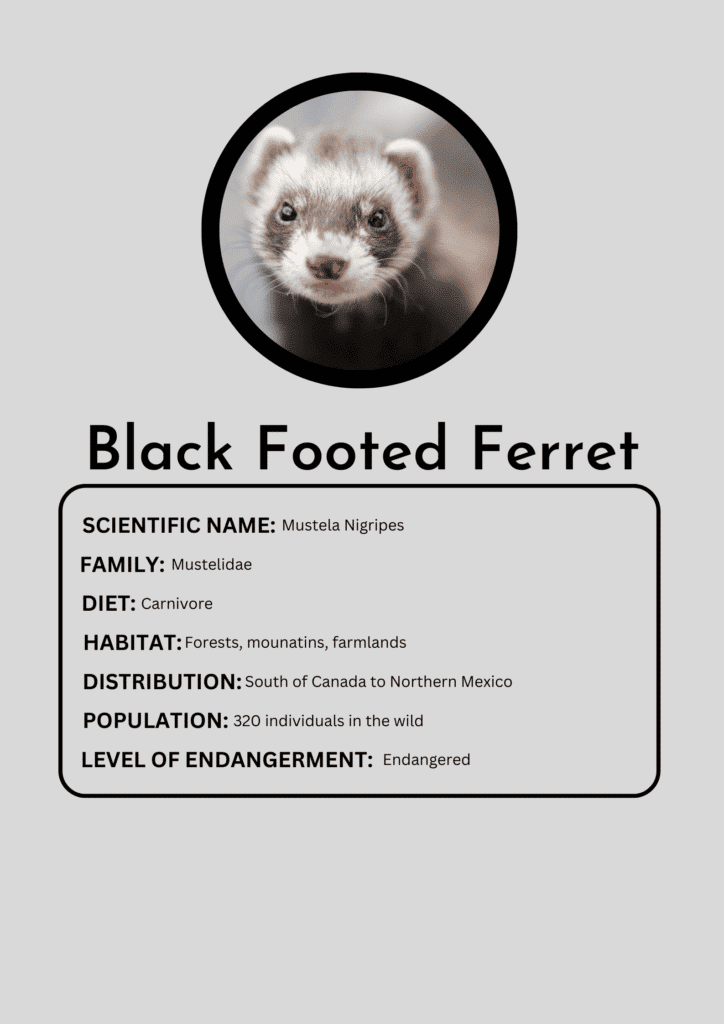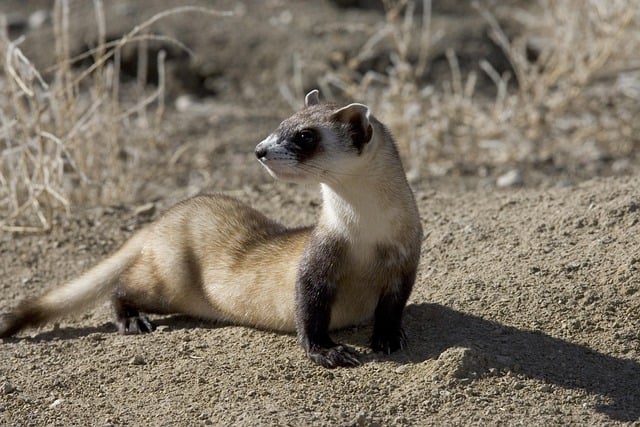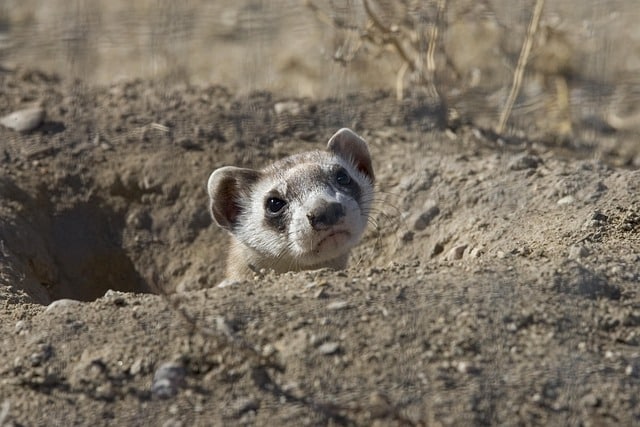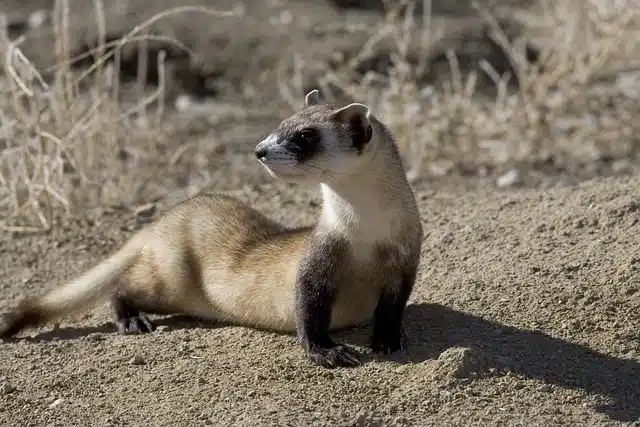Welcome to the Black Footed Ferret. A little fury friend that lives in North America. Enjoy reading!

Appearance
The black footed ferret forms part of the mustelidae family. This family also encompasses weasels, otters, minks and badgers, amongst other species.
Their appearance is almost identical to that of their cousin: the common ferret. What sets them apart, though, and what grants them their name, is the dark fur shaped like a mask around their eyes and the brown markings on their paws and the tip of their tail.
They are nimble and agile creatures. Even when fully grown, they rarely reach one kilogram in weight – males being only slightly larger than females. On average, they measure between 38-50 cm, with an added tail length of 11-15 cm. In other words, the tail almost compromises as much as a quarter of its total length.
In contrast to their long bodies, their legs are short and staunch. It is thanks to their slender size, and strong claws that they are able to squeeze into small holes and burrows.
Habitat and distribution

Black footed ferrets are the only ferret species native to North America. Formerly, they resided throughout the Great Plains, although their territory ranged all the way from southern Canada to Northern Mexico.
In an attempt to avoid their extinction, artificial re-introduction in the areas of Wyoming, South Dakota, Montana and Arizona are underway. Today merely one wild population of black footed ferrets still exists, located in Wyoming.
Short- and mixed-grass prairies, shrub-steppe, desert grassland and mountain grasslands are the types of landscapes they prefer inhabiting. Because prairie dogs constitute a principal part of the ferret’s diet, their presence is closely connected to the occurrence of prairie dogs.
Similarly, black footed ferrets use the prairie dogs’ burrows as nests. These burrows provide them with a space to nurse their offspring, protect them from predators and shelter them from cold climates. Despite being well-equipped for nature’s elements, they sometimes spend up to 6 consecutive days inside their burrows during winter.
The size of a female’s territory is usually around 40 acres, whereas a male’s territory can stretch over 340 acres. This is so because females only prioritize access to food sources for their offspring. Males, on the other hand, ensure that their territory overlaps with several females for mating purposes.
Diet
Despite their seemingly cuddly appearance, the black footed ferret is of a very aggressive nature and makes a highly skilled hunter. As previously mentioned, prairie dogs are their primary source of food. Despite their name, prairie dogs are, in fact, not canines but a kind of ground squirrel.
Although the black footed ferrets are small in size, they are hungry creatures required to feed on prairie dogs every 3-4 days, and even more frequently if it is a female caring for her kits. If they can’t come across any prairie dogs, they are equally happy snacking on mice, white-tailed jackrabbits, reptiles and insects – depending on what’s available in their particular geographical location.
Moreover, they are nocturnal animals, meaning that the black footed ferret is most active during the night time.
Mating and life cycle

Typically, the black footed ferret lives in solitude with the exception of mating and raising their offspring. The mating season falls between March and April.
Their offspring are called kits. From May – June, the mother gives birth to a litter of up to 6 kits, although 3 is the average number. Newly born kits are blind and only coated with thin white fur. It is only after three weeks that their distinctive dark markings make an appearance. After another three weeks before their eyes open.
Kits spend the first period of their lives underground before emerging and seeing sunlight for the first time after six weeks. Kits stay with their mom for the duration of the summer and become independent and disperse by September. Male kits will usually separate from the mother earlier than female ones.
At one year old, they reach sexual maturity. In captivity, ferrets are able to reach an age of 12 years in the wild. However, they rarely make it past five years due to various threats. Moreover, ferrets that are born in captivity and then reintroduced lack certain survival skills, adding further to their mortality rate.
Cause of Endangerment

Unlike many other endangered species, the black footed ferret’s endangerment does not stem from being actively targeted by humans – although their fur was sought after for a brief period at the beginning of the 1800s. Instead, it is because of a drastic decline of their main food source, the prairie dog, which causes their endangerment.
Prairie dogs and their underground burrows posed huge complications for agricultural activities during the 20th century. Consequently, with government assistance, farmers eradicated most of the prairie dog population, leaving black footed ferrets with nothing to eat and causing them to starve.
If not suffering starvation, many black footed ferrets died from the poison used to annihilate the prairie dog population when consuming infected prairie dogs. In fact, they had already been declared extinct when a population in the wild was encountered in 1981.
Various conservation programs are currently underway, although they vary in success. According to estimations, 320 individuals exist in the wild at the moment. Additionally, golden eagles, coyotes and horned owls pose a threat as they prey on black footed ferrets.
Fun Facts – That We bet You Didn’t Know
Beginning already during the Roman Empire, humans have used ferrets for the process of “ferreting”. The process entails interjecting ferrets into burrows in order for them to chase out other unwanted animals, such as rats or rabbits.
When bred in captivity, ferrets are also easily domesticated and make good pets. Tame ferrets act similar to cats, attain a playful nature and become keen on cuddles. Even in the wild, they have a playful nature – to show excitement or enjoyment, they do a little dance by arching their back and hopping back and forth, called “the ferret dance” of the “war dance”.
Moreover, they are also similar to cats in that they communicate vocally. They hiss to express anger or discomfort, they yelp to announce danger and ferret mothers produce a whimpering noise to direct or guide their offspring.
Join our Forum for free today!




